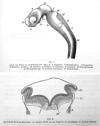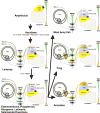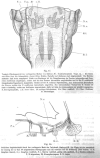Wilhelm His' lasting insights into hindbrain and cranial ganglia development and evolution
- PMID: 29447907
- PMCID: PMC6087689
- DOI: 10.1016/j.ydbio.2018.02.001
Wilhelm His' lasting insights into hindbrain and cranial ganglia development and evolution
Abstract
Wilhelm His (1831-1904) provided lasting insights into the development of the central and peripheral nervous system using innovative technologies such as the microtome, which he invented. 150 years after his resurrection of the classical germ layer theory of Wolff, von Baer and Remak, his description of the developmental origin of cranial and spinal ganglia from a distinct cell population, now known as the neural crest, has stood the test of time and more recently sparked tremendous advances regarding the molecular development of these important cells. In addition to his 1868 treatise on 'Zwischenstrang' (now neural crest), his work on the development of the human hindbrain published in 1890 provided novel ideas that more than 100 years later form the basis for penetrating molecular investigations of the regionalization of the hindbrain neural tube and of the migration and differentiation of its constituent neuron populations. In the first part of this review we briefly summarize the major discoveries of Wilhelm His and his impact on the field of embryology. In the second part we relate His' observations to current knowledge about the molecular underpinnings of hindbrain development and evolution. We conclude with the proposition, present already in rudimentary form in the writings of His, that a primordial spinal cord-like organization has been molecularly supplemented to generate hindbrain 'neomorphs' such as the cerebellum and the auditory and vestibular nuclei and their associated afferents and sensory organs.
Copyright © 2018 Elsevier Inc. All rights reserved.
Figures








Similar articles
-
Historical perspective on neuroembryology: Wilhelm His and his contemporaries.Genesis. 2018 Jun;56(6-7):e23218. doi: 10.1002/dvg.23218. Genesis. 2018. PMID: 30134065 Review.
-
The neural crest and evolution of the head/trunk interface in vertebrates.Dev Biol. 2018 Dec 1;444 Suppl 1:S60-S66. doi: 10.1016/j.ydbio.2018.01.017. Epub 2018 Feb 7. Dev Biol. 2018. PMID: 29408469 Review.
-
Coupling the roles of Hox genes to regulatory networks patterning cranial neural crest.Dev Biol. 2018 Dec 1;444 Suppl 1:S67-S78. doi: 10.1016/j.ydbio.2018.03.016. Epub 2018 Mar 20. Dev Biol. 2018. PMID: 29571614 Review.
-
Analysis of hindbrain neural crest migration in the long-tailed monkey (Macaca fascicularis).Anat Embryol (Berl). 1996 Sep;194(3):235-46. doi: 10.1007/BF00187134. Anat Embryol (Berl). 1996. PMID: 8849670
-
Semaphorin/neuropilin signaling influences the positioning of migratory neural crest cells within the hindbrain region of the chick.Dev Dyn. 2005 Apr;232(4):939-49. doi: 10.1002/dvdy.20258. Dev Dyn. 2005. PMID: 15729704
Cited by
-
Molecular Organization and Patterning of the Medulla Oblongata in Health and Disease.Int J Mol Sci. 2022 Aug 17;23(16):9260. doi: 10.3390/ijms23169260. Int J Mol Sci. 2022. PMID: 36012524 Free PMC article. Review.
-
Understanding Molecular Evolution and Development of the Organ of Corti Can Provide Clues for Hearing Restoration.Integr Comp Biol. 2018 Aug 1;58(2):351-365. doi: 10.1093/icb/icy019. Integr Comp Biol. 2018. PMID: 29718413 Free PMC article.
-
Axonal Projection Patterns of the Dorsal Interneuron Populations in the Embryonic Hindbrain.Front Neuroanat. 2021 Dec 24;15:793161. doi: 10.3389/fnana.2021.793161. eCollection 2021. Front Neuroanat. 2021. PMID: 35002640 Free PMC article. Review.
-
Gene networks and the evolution of olfactory organs, eyes, hair cells and motoneurons: a view encompassing lancelets, tunicates and vertebrates.Front Cell Dev Biol. 2024 Mar 12;12:1340157. doi: 10.3389/fcell.2024.1340157. eCollection 2024. Front Cell Dev Biol. 2024. PMID: 38533086 Free PMC article. Review.
-
Evolution and development of extraocular motor neurons, nerves and muscles in vertebrates.Ann Anat. 2024 Apr;253:152225. doi: 10.1016/j.aanat.2024.152225. Epub 2024 Feb 10. Ann Anat. 2024. PMID: 38346566 Free PMC article. Review.
References
-
- Atwell WJ, Danchakoff V. A human embryo with seventeen pairs of somites. Carnegie Institution of Washington; 1930.
-
- Bermingham NA, Hassan BA, Wang VY, Fernandez M, Banfi S, et al. Proprioceptor pathway development is dependent on Math1. Neuron. 2001;30:411–422. - PubMed
-
- Bonito M, Glover JC, Studer M. Hox genes and region-specific sensorimotor circuit formation in the hindbrain and spinal cord. Developmental Dynamics. 2013;242:1348–1368. - PubMed
Publication types
MeSH terms
Personal name as subject
- Actions
Grants and funding
LinkOut - more resources
Full Text Sources
Other Literature Sources

